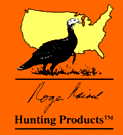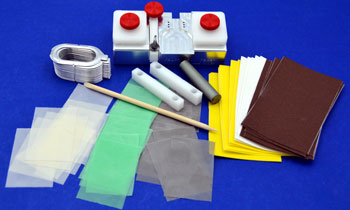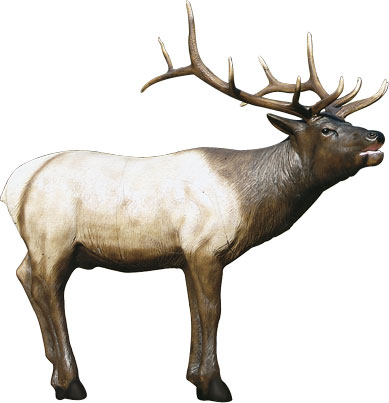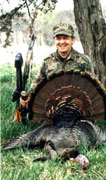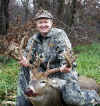| Spring gobblers either love or hate decoys depending on
their mood and how the decoys are used. There are three key questions about decoy use: |
Do they work?
|
What type to use?
|
| How to hunt with them safely? |
The following SECRETS
will teach you how and when to use them safely.
|
The reason to use decoys is to draw a gobbler's attention
away from you and to entice him into close range.
|
Use decoys that look realistic and ones that will stand up
to hard use. Collapsible decoys, both a Hen and Jake are preferred by Master Turkey Hunters because they're quick
and easy to set up, lightweight, and are noiseless when carried.
|
Despite the most realistic looking and acting decoys, your
experience with decoys will vary and there are a lot of tricks to keep in mind when using
any decoy.
|
For example, a friend of mine forgot to take down his
plastic, hard-bodied, decoy when he left his calling location. When he returned to
retrieve it a few hours later, he found if off the stake, pecked full of holes and nearly
20 yards away from the stake. And, there was a large torn up area with hundreds of turkey
tracks in it right next to the decoy. I've even watched gobblers
carry collapsible decoys away in their beaks!
|
On the other hand, I've watched plenty of gobblers retreat
from both hen and male decoys, watched others fight hen decoys, watched gobblers totally
ignore a male decoy that was very close to a real hen or hen decoy, and watched gobblers
breed jake decoys. No decoy type or tactic will work every time.
|
A final tip on movement....if you use regular decoys, any
lateral movement of the decoy on the stake, such as when the winds blows, will usually
spook a gobbler at close range too. To prevent this, place a stick in the ground on each
side of the tail so the decoy doesn't move more than about 5" laterally.
|
Early season gobblers are still quite aggressive with any
other male in the area, which is why male decoys work through mid-season. Later on in the
season, most gobblers have lost their aggressive behavior and replaced it with great
caution. Then is when a Movement Hen Decoy can really shine.
|
You can and will have mixed results with decoys. I've
watched gobblers run the other direction when they first spotted a decoy. Younger gobblers
(jakes and two-year old adults) are often quite wary of a full strut decoy, jake decoy, or
a group of decoys because they have been dominated, spurred, chased and generally made to
feel not-wanted by older gobblers during the spring season.
|
Positioning a decoy is critical.
If it's too far away, say 25 yards, and a gobbler comes in on the far side, spies it at 25
yards, he may hang up. He'd then be out of range at 50 yards and probably won't come
closer.
|
For maximum effectiveness, place your decoy(s) no more
than 15 yards away. When bow hunting, a decoy should be even closer at 6-10 yards.
|
Being near a decoy can be dangerous
because other hunters may mistake your calling and the sight of a decoy for what they
think is a real turkey, causing them to take a shot in your direction. This is
particularly true when using a male decoy, or a movement decoy.
|
To protect yourself, sit in an area
with flat terrain and against a tree larger than your body. Place your decoy(s) in
front of you, not to the sides or behind you. Then, the danger zone has been significantly
reduced to the area in front of you which you can watch. To further reduce danger, tie a
small piece of blaze orange material to a decoy.
|
If another hunter approaches, signal him/her with a human
voice, not with a turkey call or by making a motion. To provide the most personal
protection while using decoys, use a Ballistic Turkey Hunter Vest,
which will repel a shotgun blast.
|
Some people claim that decoys with a portion of their body
painted blaze orange may provide a bit more protection. But turkeys see color very well.
Too much out-of-place color will usually cause a gobbler to retreat, especially too much
blaze orange.
|
Setting up properly with realistic-looking and acting
decoys will provide the best odds for success, keeping in mind the safety issues.
|
I suggest using more than one decoy.
During a recent spring, I was able to bag two gobblers with bow and arrow while using
Hot Hen Decoys and
a Jake Decoy --each
on the first day out.
|
| DON'T USE DECOYS WHEN OTHERS MAY
BE NEAR OR IN HEAVILY-HUNTED PUBLIC AREAS!! |
The risk may be too high regardless of the precautions you
take. PLAY IT SAFE! Practice Defensive Turkey Hunting to protect
yourself.
|
| top
^ |
